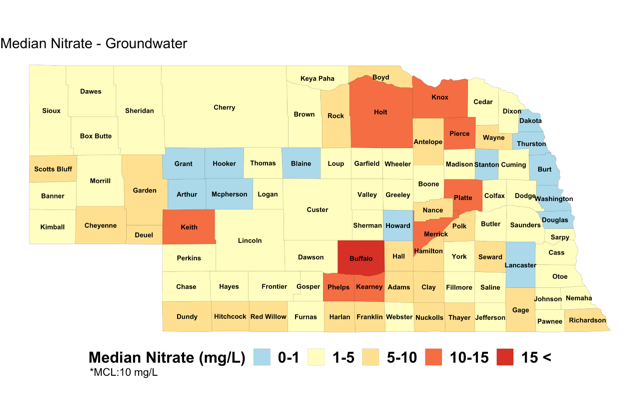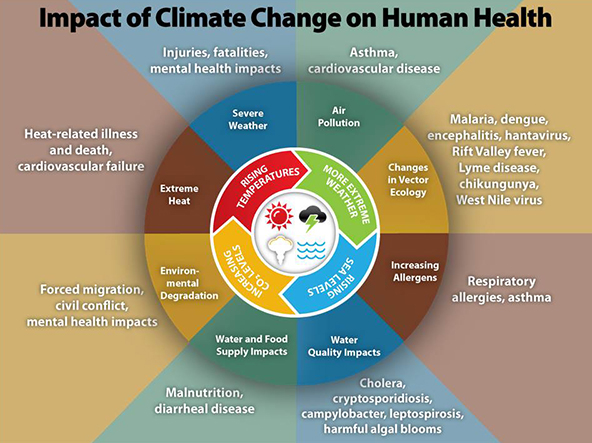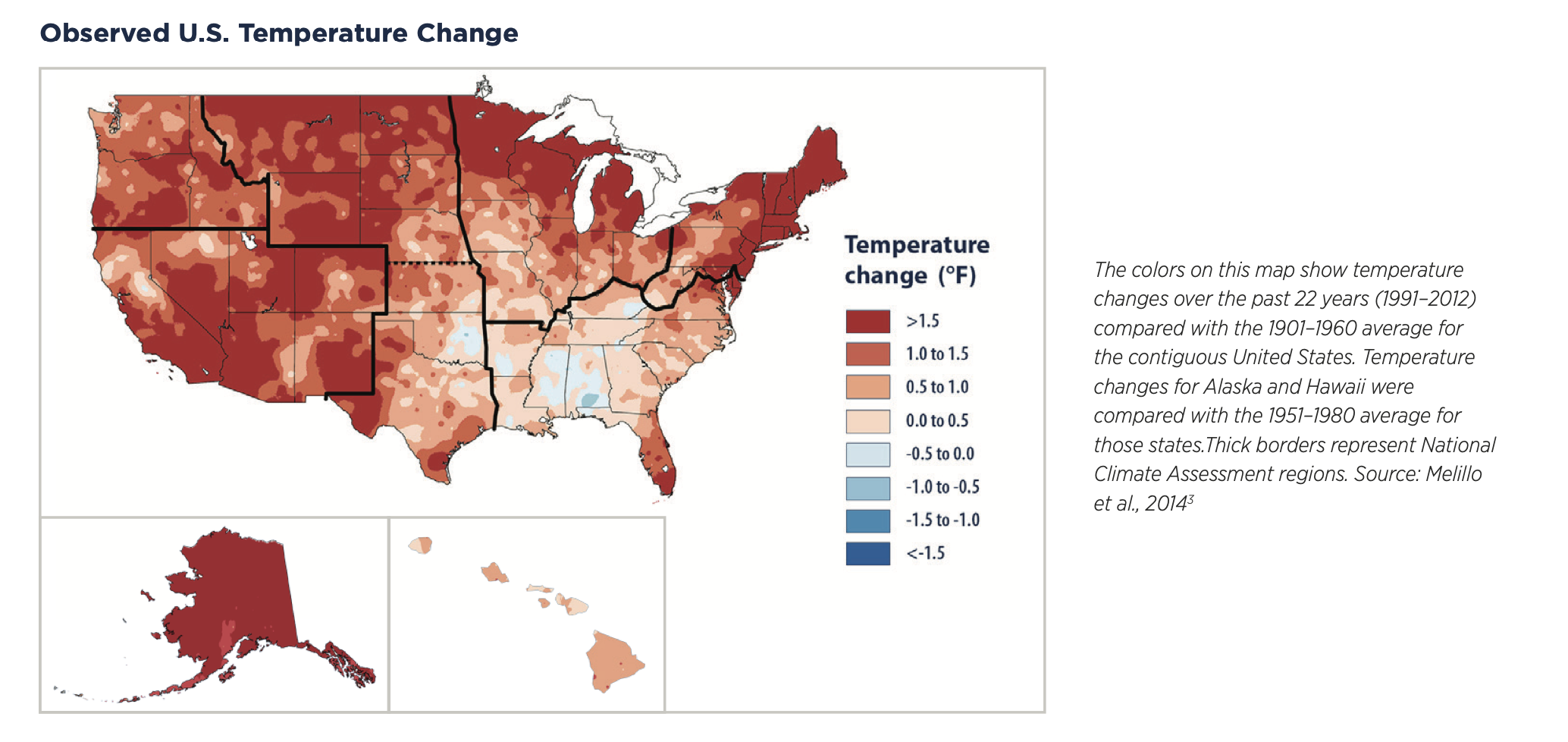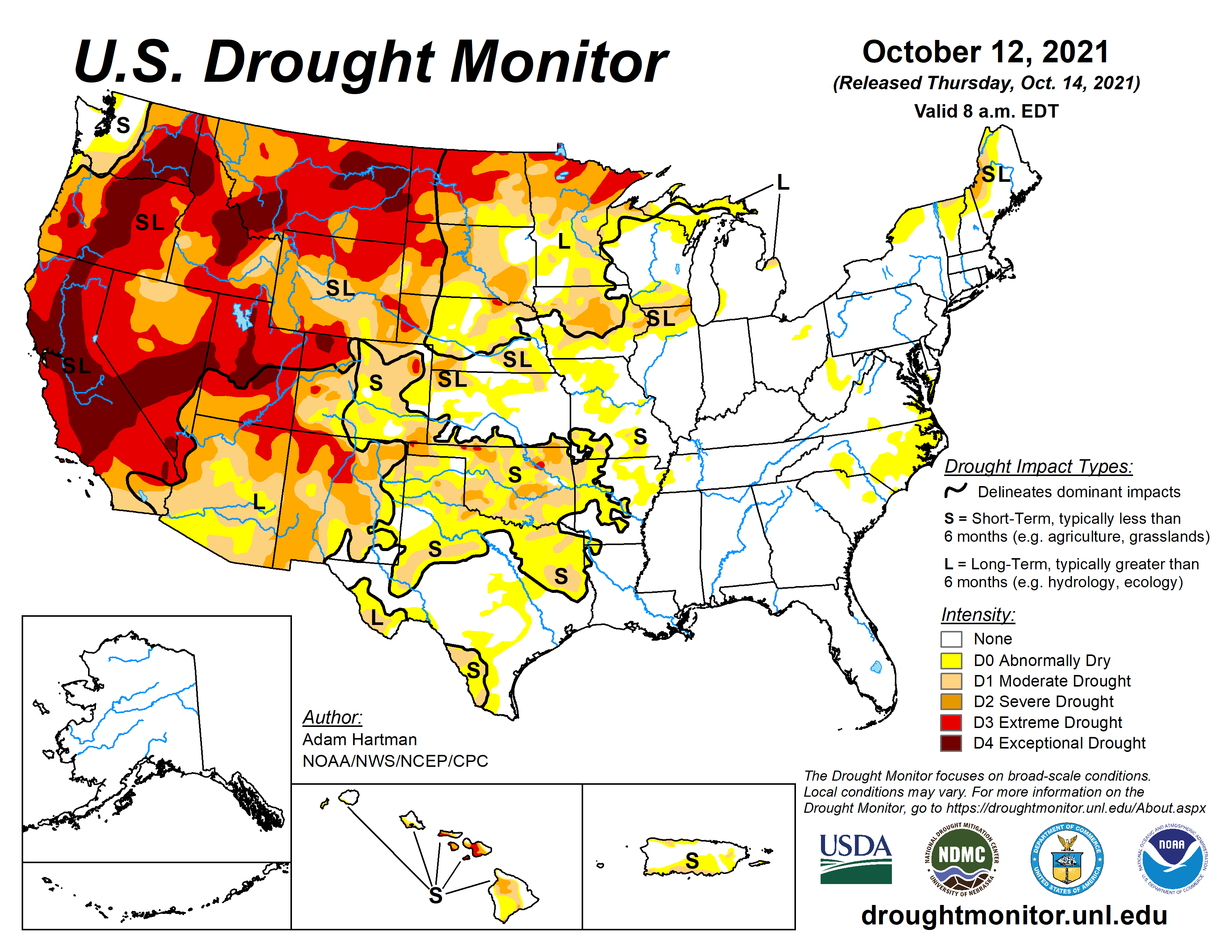Water Quality and Health
The Water, Climate and Health Program is dedicated to researching the human health outcomes associated with water contamination, with primary focus on water quality issues of relevance to Nebraska, such as nitrate and atrazine contamination of private drinking wells.
Water contamination comes from naturally occurring sources (e.g. uranium or selenium) and human activity (e.g. agricultural production), and can result in negative human health outcomes. Atrazine and nitrate are important for agricultural production, but frequently make their way into groundwater, sometimes contaminating private drinking wells. Atrazine exposure is associated with various negative reproductive outcomes such as pre-term delivery, low birth weight, and birth defects. Nitrate exposure in drinking water is also associated with many negative health outcomes such as methemoglobinemia (“blue baby syndrome”), specific types of cancer and birth defects. This is particularly important for Nebraska as one in five citizens rely on private wells for drinking water, which are not routinely tested or regulated by the Safe Drinking Water Act.


Further scientific inquiry into how atrazine and nitrate contamination is impacting the health of Nebraskans is needed. Our State has one of the highest pediatric cancer rates in the nation (Centers for Disease Control and Prevention, 2018), as well as concerningly high birth defect rates. The Water, Climate and Health Program is dedicated better understanding these issues to help provide more targeted public health interventions.
Climate Change and Health

Extreme Heat:
The United States experiences more frequent and intense heatwaves than in the past, and this trend is expected to worsen over time. Extreme heat is a threat to human health for a variety of reasons. In the United States, temperature causes more deaths than any other climate-related event. The number of deaths is due to the spatial and temporal occurrence of extreme heat events, as these events can occur multiple times a year at any location. Increased hospitalizations can occur due to acute (e.g. heat stroke) and chronic (e.g. asthma and diabetes) health issues. Some populations are more at-risk to these events, such as outdoor workers, student athletes, people without air conditioning, older adults, and children. Extreme heat also puts stress on agricultural crops and livestock. The risk of extreme heat increases during droughts and other natural disasters. It is important to understand how extreme heat is affecting our populations. By better understanding these issues, we can better prepare our communities for these threats.

Flooding:
Nebraska is one of the most flood-prone states in the United States. Variable climate and miles of winding rivers provide conditions that can quickly cause devastation. In 2019, Nebraska was the epicenter of the costliest inland flooding event in U.S. history. Precipitation patterns have changed over the last century. The frequency of flooding rains and total yearly precipitation have increased for most of the U.S. In the future, winter precipitation in Nebraska is projected to increase. There are immediate risks to human health from flooding, such as injury and drowning. However, delayed or indirect impacts from flooding can be more costly to human health, as flood water can cause contamination to drinking water and damage to infrastructure. Researching the impacts of flooding on populations will improve public health preparedness and reduce health costs in the future.
Drought:
On the other end of the precipitation spectrum is drought. We usually think of drought in the context of agriculture and water resources. However, more effort is going into understanding the health impacts associated with drought. Droughts have likely caused more deaths internationally than any other climate-related disaster, due to famine and malnutrition. In the United States, we are still understanding all the linkages of drought to human health. It can be difficult to determine the health impacts associated with drought. Droughts are slow evolving natural disasters, and the health impacts are only delayed and indirect. However, droughts are threat multipliers. Droughts reduce water quality/quantity, cause poor air quality, increase the likelihood of fires, and intensity of heat waves. Health outcomes are associated with these threats. Understanding the role of drought on human health outcomes can empower public health officials to address this issue and improve our health.

(Hartman, 2021)
Currently Funded
Title: Evaluation of Drought Indicators for Improved Decision-Making in Public Health and Emergency Preparedness: Reducing Drought’s Burden on Health.
Funding Agency: U.S. National Oceanic and Atmospheric Administration
Timeline: 2020-2022
Brief description: Health departments and healthcare professionals need reliable information to effectively prepare and warn constituents of pending natural and biological threats. This information is critical to develop hazard messaging or other response actions in a timely fashion. This project will take an interdisciplinary approach to improve public health understanding of drought early warning and planning to reduce negative health impacts of at-risk populations in the United States.
Goal: The proposed project will assist in the development of joint decision-making tools for public health stakeholders impacted by drought and improve connections between drought early warning and healthcare, leading to improvements in preparedness and climate resilience.
Title: Water, Climate and Health Program
Funding Agency: Claire M. Hubbard Foundation
Timeline: 2020-2025
Brief description: This funding is to develop work on addressing environmental health issues. The goal of this project is to bring together expertise and resources to form collaborations to address public health challenges related to water and climate, and to create solutions to these challenges.
Goal: This funding creates a state-of-the-art institution to address issues associated with climate change, water availability, and water quality.
Title: Expanding the Science and Preparedness Activities for Health Issues Associated with Drought
Funding Agency: National Oceanic and Atmospheric Administration
Timeline: 2019-2022
Brief description: This funding is to continue and expand work from the project titled, “Drought-related health impacts: advancing the science for public health”. This work is to evaluate changes in mortality rates during drought periods. The other task of this work is to host regional drought and health workshops to scope public health response to drought events in the United States.
Goal: This contract is to create a national strategic plan for the National Integrated Drought Information System on engaging with public health officials to respond to drought.
Title: Understanding the Relationship Between Drought and Suicide in all age groups in HHS Region 7 including Nebraska, Iowa, Kansas, and Missouri
Funding Agency: Innovation Fund, UNMC
Timeline: 2020-2021
Brief description: Drought can cause or worsen a variety of health conditions ranging from cardiovascular and respiratory issues to mental health disorders. Because drought is a slow-moving natural disaster, the psychological effects of living through such conditions are more subtle and last longer than other natural disasters. An analysis by the Nebraska Department of Health and Human Services (DHHS) showed that suicides in rural Nebraska counties spiked after the 2012 drought.
Goal: The goals of this project are to improve our understanding of the effects of drought exposure on suicide rates in Nebraska for all age groups and also to develop message maps targeted towards public health and healthcare providers that communicate the effects of drought on the suicide rate of vulnerable communities and at-risk populations.
Title: Exploring the Relationship between Heatwaves and Cardiovascular Problems in Omaha, Nebraska
Funding Agency: Innovation Fund, UNMC
Timeline: 2020-2021
Brief description: Heatwaves are prolonged periods of extreme temperatures that can cause health problems for different regions. About 6200 Americans on average are hospitalized each summer due to excessive heat, and those at highest risk are poor, uninsured, and elderly.
Goal: The goal of this project is to investigate the effects of extreme temperature on cardiovascular health outcomes among Nebraskans.
Title: Regional dust storm forecasting for Valley fever surveillance and highway accident prevention in the western United States
Funding Agency: National Aeronautics and Space Administration (NASA)
Timeline: 2019-2021
Brief description: The proposed research aim is to apply NASA satellite products and novel data assimilation techniques to improve the nation’s operational dust storm forecasting system, so that the enhanced dust prediction can be integrated into three decision-support systems: air quality management, Valley fever surveillance, and highway safety.
Goal: This funding produced science applications for cutting edge satellite air quality monitoring products.
Past Projects:
Title: Drought-Related Health Impacts: Advancing the Science for Public Health Applications
Funding Agency: National Oceanic and Atmospheric Administration
Timeline: 2018-2019
Brief description: This funding was designed to develop three projects that are designed to advance our understanding of the impacts of drought on human health. The project is also identifying opportunities to forge an alliance between drought and public health communities to collectively address potential health outcomes from drought. The first project is building on his previous work to determine the role of soil moisture on predicting incidence of Valley fever. The second task is evaluating the changes in mortality rates during periods of drought. The third task is to identify and scope opportunities for future interaction/collaboration with drought communities and public health communities through a series of strategic workshops. This project is in the second year of funding and has produced a National Drought and Public Health Summit in Atlanta, along with subsequent regional workshops.
Goal: This project was one of the first projects to evaluate and understand the impacts of drought on human health in the United States.
Title: Using Extreme Weather Event Attribution to Determine the Impacts of Climate Change on Human Health
Funding Agency: Society of Actuaries
Timeline: 2019-2020
Brief description: Climate change is already a threat to human health. Evidence has linked climate change to increases in the frequency and intensity of some extreme weather events. Because of scientific advances in understanding the relationship between climate change and extremes, the conversation can now transition from identifying changes in historical trends of extreme events to determining the effect climate change has on a given single extreme event. This new study area in climate science is called extreme event attribution. Understanding these relationships provides new opportunities to determine the current and project the future impacts of climate change on society and the health delivery system. The connection between extreme weather events and human health is already well established. With the advent of extreme event attribution, there is now an opportunity to identify the contribution that climate change has on human health, and the cost of healthcare, because of more intense and frequent extreme events in many parts of the world. The goal of this project is to provide examples of the influence climate change has on extreme events and link this additional burden to health needs and the cost of care.
Goal: This project helped inform the health insurance industry and healthcare actuarial community on the potential impacts climate change is already having on their fields. In particular, the results of this project provide a quantitative methodology for insurance companies to understand the potential impacts that these events have on their current and future risk profile and resulting costs.
For more information on climate change and health:
2020 Report - Lancet Countdown
The United Nations’ Intergovernmental Panel on Climate Change

